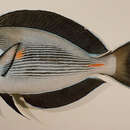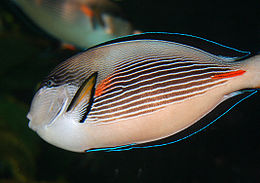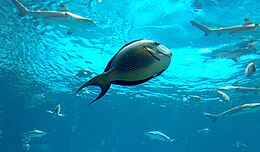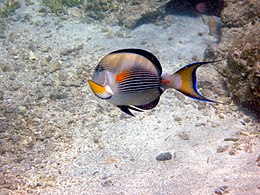tr
kırıntılardaki isimler


Acanthurus sohal és una espècie de peix pertanyent a la família dels acantúrids.[4] Pot arribar a fer 40 cm de llargària màxima.[5][6] És un peix marí, associat als esculls[7] i de clima tropical (24°C-30°C) que viu normalment entre 0-20 m de fondària.[5][8] Menja diversos tipus d'algues, principalment del gènere Sargassum.[5] Es troba al mar Roig i el golf Pèrsic.[5][9][10][11][12][13][14] És agressiu i territorial.[15] És inofensiu per als humans.[5]
Acanthurus sohal és una espècie de peix pertanyent a la família dels acantúrids. Pot arribar a fer 40 cm de llargària màxima. És un peix marí, associat als esculls i de clima tropical (24°C-30°C) que viu normalment entre 0-20 m de fondària. Menja diversos tipus d'algues, principalment del gènere Sargassum. Es troba al mar Roig i el golf Pèrsic. És agressiu i territorial. És inofensiu per als humans.



Der Arabische Doktorfisch (Acanthurus sohal), auch Sohaldoktorfisch, ist eine Art aus der Familie der Doktorfische (Acanthuridae) und gehört in dieser der Unterfamilie der Skalpelldoktorfische (Acanthurinae) an.
Der häufig zu beobachtende Arabische Doktorfisch kommt im Roten Meer und im Persischen (=Arabischen) Golf vor, wo er bevorzugt an korallenreichen Saumriffen lebt. Er hält sich meist an der Wasseroberfläche auf, nur sehr selten ist er in Gewässertiefen unter 10 Metern zu beobachten.
Wie die meisten Doktorfischarten auch hat der Arabische Doktorfisch einen längsovalen, seitlich abgeflachten Körper. Das Maul ist endständig und die Augen liegen relativ weit oben. Die Schwanzflosse ist stark sichelförmig ausgezogen, Rücken und Afterflosse sind dagegen abgerundet und können beim Imponierverhalten aufgestellt werden. Rücken-, After- und Schwanzflosse sind schwarz gefärbt und haben jeweils einen blauen Rand. Auf den Flanken trägt der Fisch ein schwarzweißes Linienmuster. Ältere männliche Doktorfische entwickeln außerdem eine Stirnbeule.
Als junger Fisch lebt der Arabische Doktorfisch entweder als ein Einzelgänger oder in Vergesellschaftung mit Jungfischen der Arten Goldtupfen-Doktorfisch und Brauner Borstenzahndoktor.
Als ausgewachsene Fische bildet die Art Haremsreviere. Mehrere Weibchen leben in eigenen kleineren Revieren; ein einzelnes männliches Tier patrouilliert auf festen Schwimmbahnen diese Reviere und verteidigt sie gegenüber Artgenossen.
Wie die meisten Doktorfischarten ist auch der Arabische Doktorfisch im Aquarium ein schwieriger Pflegling. Der Fisch hat ein ausgeprägtes Schwimmbedürfnis, er benötigt ein sehr großes Becken und bringt durch rastloses Schwimmen viel Unruhe in die im Aquarium gehaltene Fischgesellschaft. Er ist außerdem unverträglich gegenüber Doktorfischarten und als revierbildender Fisch auch gegenüber Artgenossen.
Der Arabische Doktorfisch (Acanthurus sohal), auch Sohaldoktorfisch, ist eine Art aus der Familie der Doktorfische (Acanthuridae) und gehört in dieser der Unterfamilie der Skalpelldoktorfische (Acanthurinae) an.
The sohal surgeonfish (Acanthurus sohal) or sohal tang, is an endemic from the Red Sea and Persian Gulf. A single record was reported in 2017 from the eastern Mediterranean Sea, a likely result of aquarium release.[1] It can grow up to 16 in (40 cm) in the wild.[2] It is a valued aquarium fish. Its striking blue and white horizontal stripes have made it for many the 'poster fish' for the Red Sea reef and Persian Gulf environment.
Like other tangs, the sohal tang is compressed laterally, making it extremely maneuverable and fast along the reef. It has a horizontal, blade-like spine along the base of its tail on both sides, which folds into the fish, pointing anteriorly towards the head. During defense and aggression, tangs flick the spine at other fish or intruders, causing physical harm. The surgeonfish are named for this scalpel-like spine.
Its primary diet consists mostly of vegetable matter, but occasionally includes the flesh of other animals. Sohal tangs have been known to nip at clam mantles and soft large-polyp and small-polyp stony corals.
Its range includes all reef environments in the Red Sea, to 90 ft or deeper. It is one of the most aggressive tangs, and combined with its large size for a tang, is a dominant fish along the Red Sea reef.
This fish needs a lot of swimming space and is a constant grazer for marine macroalgae. Its innate dominant and aggressive nature suggest only a single specimen should be kept in each aquarium. If healthy, aquarium specimen should live up to 10–15 years.
Alertness, swimming behavior and breathing rate should be the main factors when choosing the ideal Sohal Tang. Smaller specimens ~3 inch or more should be considered as it is better able to adapt to the aquarium environment and diet. Specimen's color should not be considered an important factor when selecting appropriate specimen.
An ideal specimen should be alert and curious, constantly swimming, breathing should be constant and show sign of aggressiveness to other tankmates.
An aquarium size of more than 180 gallons (700 ℓ), with strong water movement and ample liverock structures are preferred for this species, due to its constant roaming nature. Due to its aggressive nature, this species should be added to the aquarium last.
Initial purchase should be Freshwater Dipped and quarantine in a designated Quarantine Tank (QT), with similar/identical water parameter. It is suggested the Quarantine Tank water should be of lower salinity as this will eliminate most ectoparasites on the body of the fish. When specimen is fully quarantined, it then can be introduced to the display aquarium.
Sohal Tang's diet should consist primarily of Algae or vegetable matter. It has been suggested that "Sushi Nori" can be the main diet of this fish. Other than Algae, the diet should be supplemented with a variety of frozen Mysis shrimps or other similar food items.
They are a constant grazer which will scrap off marine algae in the aquarium. It is therefore recommended that it be fed several times each day.
Sohal tang care sheet at FishGeeks
The sohal surgeonfish (Acanthurus sohal) or sohal tang, is an endemic from the Red Sea and Persian Gulf. A single record was reported in 2017 from the eastern Mediterranean Sea, a likely result of aquarium release. It can grow up to 16 in (40 cm) in the wild. It is a valued aquarium fish. Its striking blue and white horizontal stripes have made it for many the 'poster fish' for the Red Sea reef and Persian Gulf environment.
Like other tangs, the sohal tang is compressed laterally, making it extremely maneuverable and fast along the reef. It has a horizontal, blade-like spine along the base of its tail on both sides, which folds into the fish, pointing anteriorly towards the head. During defense and aggression, tangs flick the spine at other fish or intruders, causing physical harm. The surgeonfish are named for this scalpel-like spine.
Its primary diet consists mostly of vegetable matter, but occasionally includes the flesh of other animals. Sohal tangs have been known to nip at clam mantles and soft large-polyp and small-polyp stony corals.
Its range includes all reef environments in the Red Sea, to 90 ft or deeper. It is one of the most aggressive tangs, and combined with its large size for a tang, is a dominant fish along the Red Sea reef.
Acanthurus sohal es un pez cirujano, de la familia Acanthuridae.
Sus nombres comunes en inglés son Sohal surgeonfish, o pez cirujano de Sohal, y Red Sea surgeonfish, o pez cirujano del Mar Rojo, debido a que su área de distribución se circunscribe al mar Rojo y la península arábiga.[3]
Posee la morfología típica de su familia, cuerpo comprimido lateralmente y ovalado. La boca es pequeña, protráctil y situada en la parte inferior de la cabeza. El hocico es grande. Tiene 8 espinas y 30 a 31 radios blandos dorsales; 3 espinas y entre 28 y 29 radios blandos anales; 17 radios pectorales; 15 a 17 branquiespinas anteriores y 14 a 15 branquiespinas posteriores. Un ejemplar de 87 mm tiene 12 dientes en la mandíbula superior y 14 en la inferior, con 270 mm de largo tiene 16 en la superior y 18 en la inferior.[4]
Como todos los peces cirujano, de ahí les viene el nombre común, tiene 2 espinas extraíbles, o escalpelos, en el pedúnculo caudal, que usan para defenderse o dominar. En su caso son largas comparativamente, finas, muy afiladas, y están cubiertas por una mancha de color naranja intenso.
Detalle de dentadura herbívora de la especie emparentada Acanthurus xanthopterus
Los dos tercios superiores del cuerpo están atravesados horizontalmente por líneas alternas marrón oscuro o negras, y blancas o azul pálido, que recorren cuerpo y parte superior de la cabeza. El tercio inferior es de color "bronceado". Las aletas dorsal, anal y pélvicas son negras y tienen el margen exterior ribeteado en azul claro. Las aletas pectorales tienen la parte anterior amarillo-anaranjado, con el margen exterior en negro. La aleta caudal es negra, con forma de luna, y bordeado su margen exterior en azul claro.
Alcanza los 40 cm de largo.[5] Su mayor longevidad reportada es de 26 años, en un ejemplar del sur de Omán.
Es una especie bentopelágica, territorial y agresiva[6] que frecuenta zonas de oleaje en arrecifes costeros expuestos hacia mar adentro. Son dioicos, de fertilización externa y no cuidan a sus crías.[7] Normalmente ocurren solitarios, recorriendo su territorio.[8]
Se desconoce su rango de profundidad, aunque se localiza usualmente entre 0 y 20 m.[9] Su rango de temperatura es tropical, entre 24 y 30ºC.
Se distribuye en el océano Índico, en el mar Rojo y la península arábiga. Es especie nativa de Arabia Saudí; Baréin; Egipto; Emiratos Árabes Unidos; Eritrea; Irán; Irak; Israel; Jordania; Kuwait; Omán; Qatar; Somalia; Sudán; Yemen y Yibuti.[10]
Es herbívoro. Se alimenta de algas bénticas y epilíticas, algas y macrófitas que crecen íntimamente asociadas a las piedras y otros sustratos.[11] Principalmente de algas verdes filamentosas, y Sargassum.[12] Al ser una especie territorial, emplea el 51,3% de su tiempo en patrullar agresivamente su territorio, con el fin de asegurar la suficiente cantidad de algas para su alimentación, a la que dedica el 33,7% de su tiempo,[8] de lo que se deduce que su principal función en el territorio es proteger sus recursos alimenticios.[13] En ocasiones forma "escuelas", o cardúmenes, para alimentarse en territorios de otros peces.[14]
Son dioicos, aunque no presentan dimorfismo sexual aparente. Son ovíparos y de fertilización externa. No cuidan a sus crías.[7] Los huevos son pelágicos, de 1 mm de diámetro, y contienen una gotita de aceite para facilitar la flotación. En 24 horas, los huevos eclosionan larvas pelágicas translúcidas, llamadas Acronurus. Son plateadas, comprimidas lateralmente, con la cabeza en forma de triángulo, grandes ojos y prominentes aletas pectorales. Cuando alcanzan 21 mm de largo, se produce la metamorfosis del estado larval al juvenil.[4] Al hacerlo, mutan su color plateado a la coloración de la especie, y las formas de su perfil se redondean.
Es una especie moderadamente difícil de mantener en cautividad y agresiva con otros peces, especialmente de su familia y/o coloración similar. Es buen nadador y requiere, por lo tanto, un acuario espacioso.
La iluminación deberá ser necesariamente intensa para que pueda desarrollarse la colonia de algas suficiente de la que se alimenta. Además requiere mantener un buen número de roca viva entre la decoración del acuario con suficientes escondrijos.
Al igual que el resto de especies de cirujanos, son muy sensibles a determinadas enfermedades relacionadas con la piel. Es recomendable la utilización de esterilizadores ultravioleta para la eliminación de las plagas patógenas.
Aunque es herbívoro, acepta tanto artemia y mysis congelados, como alimentos disecados. No obstante, una adecuada alimentación debe garantizar el aporte diario de vegetales, sean naturales o liofilizados, alga nori, espirulina, etc.






Acanthurus sohal es un pez cirujano, de la familia Acanthuridae.
Sus nombres comunes en inglés son Sohal surgeonfish, o pez cirujano de Sohal, y Red Sea surgeonfish, o pez cirujano del Mar Rojo, debido a que su área de distribución se circunscribe al mar Rojo y la península arábiga.
Acanthurus sohal Acanthurus generoko animalia da. Arrainen barruko Actinopterygii klasean sailkatzen da, Acanthuridae familian.
Acanthurus sohal Acanthurus generoko animalia da. Arrainen barruko Actinopterygii klasean sailkatzen da, Acanthuridae familian.
Linjavälskäri (Acanthurus sohal) on välskärikaloihin kuuluva kala.
Linjavälskäri kasvaa akvaariossa 25 cm pitkäksi, luonnossa jopa 40 cm.[2] Sen vartalo on pohjaväriltään tummansininen, ja siinä on vaakasuuntaisia valkeita "liituraitoja". Selkä- ja vatsaevät sekä pyrstö ovat tummansiniset, mutta niiden reunassa kulkee neonsininen raita. Sivuevissä on häivähdys oranssia.
Linjavälskäreitä elää koralliriutoilla Punaisellamerellä sekä Persianlahdella. Se viihtyy riuttojen läheisyydessä, mutta tarvitsee paljon vapaata uintitilaa.
Linjavälskäri on hyvin aggressiivinen lajitovereitaan ja muita välskäreitä kohtaan. Sitä suositellaan pidettäväksi vain suurissa akvaarioissa muiden aggressiivisten kalojen joukossa.[3]
Muiden Punaisenmeren kalojen tapaan linjavälskärit tarvitsevat tasaiset, hyvät vesiolot. Suolapitoisuuden pitäisi pysyä vakiona niin että ominaistiheys on 1.025, pHn välillä 8.2–8.4 ja lämpötilan 25–28 °C. Kala syö paljon, joten se tuottaa paljon jätettä, joten veden kiertoon ja puhdistukseen on kiinnitettävä huomiota.[4]. Ne syövät pääasiassa kasvisruokaa, etenkin akvaariossa kasvavaa levää mutta myös kuivaruokaa.
Linjavälskäri (Acanthurus sohal) on välskärikaloihin kuuluva kala.
Acanthurus sohal, communément appelé Poisson-chirurgien zébré, est une espèce de poissons de la famille des Acanthuridae.
Sa taille maximale connue est de 40 cm mais n'excède pas les 20 cm en aquarium. Cette espèce est très territoriale et ne partage pas souvent son platier avec d'autres poissons brouteurs d'algues[2].
C'est un poisson des récifs coralliens, que l'on trouve notamment sur les tombants récifaux agités, entre la surface et 50 m de profondeur. Il est principalement répandu en mer Rouge et autour de la péninsule arabique[2], mais on le retrouve parfois aussi jusqu'à La Réunion.
En décembre 2014, l'Aquarium du palais de la Porte Dorée détenait un spécimen d’Acanthurus sohal présenté au public. Il était maintenu dans une grande cuve de poissons d'eau de mer et en compagnie d'autres espèces de provenance similaire. Il est aisément observable lors d'une promenade dans l'aquarium.
Individu au Birch Aquarium (en).
Acanthurus sohal, communément appelé Poisson-chirurgien zébré, est une espèce de poissons de la famille des Acanthuridae.
Acanthurus sohal (Forsskål, 1775), conosciuto comunemente come pesce chirurgo sohal, pesce chirurgo zebrato o pesce chirurgo arabo, è un pesce d'acqua salata appartenente alla famiglia Acanthuridae.
È una specie endemica del Mar Rosso, dove popola la barriera corallina prediligendo le zone poco profonde e le pozze di marea, spingendosi fino a 10 metri di profondità. È comune anche nel Mar Arabico e nel Golfo di Aden, la sua presenza è segnalata lungo il litorale orientale africano fino alle Seychelles. Vive in acque con temperatura tra i 24 e i 27 °C.
Il pesce chirurgo presenta un corpo marcatamente ovale e la coda a forma di mezzaluna. La pinna dorsale è unica, nera bordata di azzurro, alla stessa stregua della pinna anale.
Si distingue facilmente per la tipica colorazione aposematica, con strisce orizzontali blu e grigie (da cui deriva il nome chirurgo zebrato) e per la presenza di due macchie gialle in corrispondenza della pinna pettorale e delle lame, ubicate ai lati del peduncolo caudale.
Gli esemplari adulti arrivano a misurare fino a 40 cm.
Acanthurus sohal è un pesce territoriale, spesso aggressivo contro gli intrusi, a difesa del territorio.
Come gli altri acanturidi, anche il pesce chirurgo sohal è erbivoro e si nutre principalmente di alghe.
Questa specie è allevata in acquari di barriera domestici e pubblici.
Acanthurus sohal (Forsskål, 1775), conosciuto comunemente come pesce chirurgo sohal, pesce chirurgo zebrato o pesce chirurgo arabo, è un pesce d'acqua salata appartenente alla famiglia Acanthuridae.
Arabinis jūrų chirurgas (lot. Acanthurus sohal, angl. Sohal surgeonfish, vok. Arabischer Doktorfisch) – chirurgžuvinių (Acanthuridae) šeimos žuvis.
De rodezeedoktersvis (Acanthurus sohal) is een doktersvis die op de koraalriffen van de Rode Zee voorkomt en ongeveer 35 cm groot kan worden. Deze doktersvis wordt geroemd vanwege zijn prachtige blauwe en zwarte horizontale strepen, en is ook geliefd als aquariumvis.
De rodezeedoktersvis heeft een plat lichaam waardoor hij zich snel en efficiënt op het rif kan rondbewegen. Om de zwarte rug- en staartvin bevindt zich een blauwe rand. Hij heeft net als andere doktersvissen aan beide zijden van het lichaam horizontale lemmetachtige stekels ter hoogte van de staartbasis. Deze zijn normaal naar voren in het lichaam gevouwen, maar klappen naar buiten als de vis zich tegen gevaar moet verdedigen, of in een gevecht met soortgenoten is verwikkeld. Volwassen mannetjes leven vaak met harems van enkele wijfjes.
Het voedsel is hoofdzakelijk plantaardig, hoewel soms ook aan dierlijk voedsel zoals poliepen van steenkoralen en mantels van weekdieren wordt geknabbeld. De rodezeedoktersvis is een van meer agressieve doktersvissen, en behoort mede door zijn grote omvang tot de dominantere vissen op het koraalrif van de Rode Zee. Hij komt voor tot op een diepte van 30 meter.
In een aquarium heeft de vis heeft veel ruimte nodig, en is voortdurend op zoek naar voedsel in de vorm van algen. Door zijn dominantie en agressiviteit is het aan te raden slechts één exemplaar in het aquarium te houden. Zij kunnen in aquaria, mits gezond, wel 10-15 jaar oud worden.
De rodezeedoktersvis (Acanthurus sohal) is een doktersvis die op de koraalriffen van de Rode Zee voorkomt en ongeveer 35 cm groot kan worden. Deze doktersvis wordt geroemd vanwege zijn prachtige blauwe en zwarte horizontale strepen, en is ook geliefd als aquariumvis.
De rodezeedoktersvis heeft een plat lichaam waardoor hij zich snel en efficiënt op het rif kan rondbewegen. Om de zwarte rug- en staartvin bevindt zich een blauwe rand. Hij heeft net als andere doktersvissen aan beide zijden van het lichaam horizontale lemmetachtige stekels ter hoogte van de staartbasis. Deze zijn normaal naar voren in het lichaam gevouwen, maar klappen naar buiten als de vis zich tegen gevaar moet verdedigen, of in een gevecht met soortgenoten is verwikkeld. Volwassen mannetjes leven vaak met harems van enkele wijfjes.
Het voedsel is hoofdzakelijk plantaardig, hoewel soms ook aan dierlijk voedsel zoals poliepen van steenkoralen en mantels van weekdieren wordt geknabbeld. De rodezeedoktersvis is een van meer agressieve doktersvissen, en behoort mede door zijn grote omvang tot de dominantere vissen op het koraalrif van de Rode Zee. Hij komt voor tot op een diepte van 30 meter.
In een aquarium heeft de vis heeft veel ruimte nodig, en is voortdurend op zoek naar voedsel in de vorm van algen. Door zijn dominantie en agressiviteit is het aan te raden slechts één exemplaar in het aquarium te houden. Zij kunnen in aquaria, mits gezond, wel 10-15 jaar oud worden.
Pokolec szary[2] (Acanthurus sohal) – gatunek morskiej ryby okoniokształtnej z rodziny pokolcowatych (Acanthuridae). Popularna w akwariach morskich[2].
Występuje w Morzu Czerwonym, Zatoce Perskiej i na rafach koralowych Oceanu Indyjskiego, na głębokościach do 20 m[3], na płyciznach i stokach raf od strony morza[2].
Dorasta do 40 cm długości. Żywi się glonami. Gatunek agresywny i terytorialny[3].
Pokolec szary (Acanthurus sohal) – gatunek morskiej ryby okoniokształtnej z rodziny pokolcowatych (Acanthuridae). Popularna w akwariach morskich.
Występuje w Morzu Czerwonym, Zatoce Perskiej i na rafach koralowych Oceanu Indyjskiego, na głębokościach do 20 m, na płyciznach i stokach raf od strony morza.
Dorasta do 40 cm długości. Żywi się glonami. Gatunek agresywny i terytorialny.
Acanthurus sohal, conhecido como cirurgião-de-sohal, é um peixe do gênero Acanthurus.[1] É endêmico do Mar Vermelho que cresce a 16 polegadas em estado selvagem. Suas notáveis listas horizontais azuis e brancas, tornou o que muitos considerem o 'peixe cartaz' ao meio ambiente dos recifes do Mar Vermelho. É um peixe de aquário valorizado.
Acanthurus sohal, conhecido como cirurgião-de-sohal, é um peixe do gênero Acanthurus. É endêmico do Mar Vermelho que cresce a 16 polegadas em estado selvagem. Suas notáveis listas horizontais azuis e brancas, tornou o que muitos considerem o 'peixe cartaz' ao meio ambiente dos recifes do Mar Vermelho. É um peixe de aquário valorizado.
Sohal kirurg (Acanthurus sohal) är en fisk som förekommer i Röda havet och kan bli upp till 40 cm. Den äter främst vegetabilier.
Sohal kirurg (Acanthurus sohal) är en fisk som förekommer i Röda havet och kan bli upp till 40 cm. Den äter främst vegetabilier.
Acanthurus sohal là một loài cá thuộc họ Cá đuôi gai. Đây là loài đặc hữu Biển Đỏ. Loài cá này có thân dài đến 16 inch trong tự nhiên. Nó là một loài cá cảnh có giá trị. Thức ăn của loài cá này chủ yếu gồm chất thực vật nhưng thỉnh thoảng nó cũng ăn thịt loài động vật khác. Chúng sinh sống ở độ sâu ít nhất 90 foot. Nó là một trong các loài cá đuôi gai hung hăng nhất, kết hợp với kích thước lớn, nó là một loài cá chiếm ưu thế ở các đá ngầm Biển Đỏ.
Acanthurus sohal là một loài cá thuộc họ Cá đuôi gai. Đây là loài đặc hữu Biển Đỏ. Loài cá này có thân dài đến 16 inch trong tự nhiên. Nó là một loài cá cảnh có giá trị. Thức ăn của loài cá này chủ yếu gồm chất thực vật nhưng thỉnh thoảng nó cũng ăn thịt loài động vật khác. Chúng sinh sống ở độ sâu ít nhất 90 foot. Nó là một trong các loài cá đuôi gai hung hăng nhất, kết hợp với kích thước lớn, nó là một loài cá chiếm ưu thế ở các đá ngầm Biển Đỏ.
Acanthurus sohal (Forsskål, 1775)
Арабский хирург[1] (лат. Acanthurus sohal) — морская лучепёрая рыба семейства хирурговых.
Общая длина тела до 40 см. Тело уплощенное с боков, хвостовой плавник в форме полумесяца. Окраска светло-серая, постепенно переходящая в белую на брюшной стороне. На голове выше глаз и на боках расположены узкие продольные чёрные полосы. Под грудными плавниками оранжевые пятна, вокруг выемки с шипом на хвостовом стебле короткая продольная оранжевая или красная полоса. Непарные плавники чёрные с узкой синей краевой каймой, грудные жёлтые вверху и белые внизу с чёрной каймой. В спинном плавнике 9 жестких и 30—31 мягких лучей, в анальном 3 жестких и 28—29 мягких, в грудных плавниках по 17 мягких лучей. Очень агрессивный территориальный вид.
Арабский хирург распространен в тропических водах западной части Индийского океана от Красного моря до Персидского залива. Обитает на внешних склонах коралловых рифов на глубине до 20 м. Населяет воды с температурой +24…+30 °C.
В 2002 году одна особь была замечена у берегов Помпано Бич (Pompano Beach) во Флориде (Северная Америка), куда попала вероятно из аквариума. В результате арабский хирург был внесён в список интродуцированных видов в США.
Питается различными видами водорослей, в основном из рода Sargassum и мелкими нитчатыми зелёными водорослями.
Арабский хирург (лат. Acanthurus sohal) — морская лучепёрая рыба семейства хирурговых.
紅海刺尾魚,俗称紅海騎士倒吊,為輻鰭魚綱鱸形目刺尾魚亞目刺尾魚科的其中一個種,身上的斑紋容易和紋倒吊搞混,但後者主要分布太平洋一帶。
水深0-20公尺。
本魚體呈橢圓形而側扁。頭小,頭背部輪廓隨著成長而略凸出。口小,端位,上下頜各具一列扁平齒,齒固定不可動,齒緣具缺刻。體為藍灰色,體後半部具有較深的顏色,略呈三角形。體全身具有白色的細縱紋,各魚鰭,除胸鰭外,皆為黑色,並有寶藍色邊緣,胸鰭灰色且具黑色邊緣。胸鰭基底及尾柄硬棘部為黃色,體長可達40公分。
本魚棲息在珊瑚礁區,具侵略性和領域性,屬草食性,以藻類為食。
為觀賞性魚類。